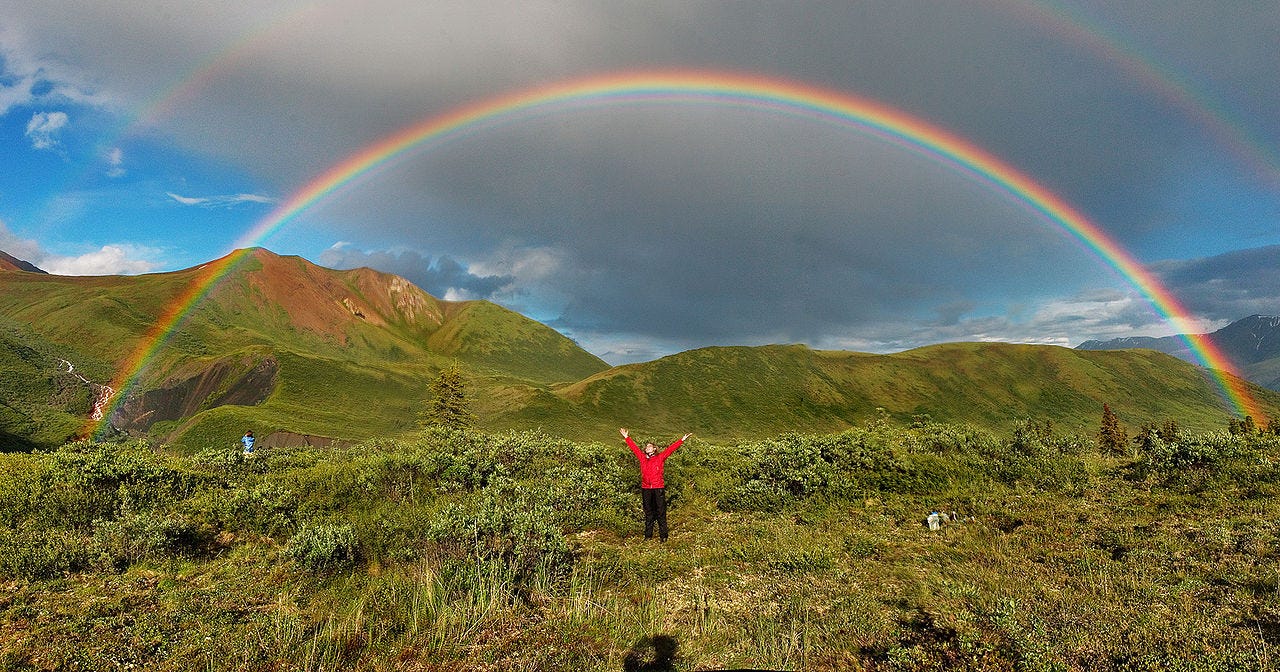Another Reason to Cherish the Home Planet - Rainbows are Rare Elsewhere
Rainbows are everywhere on Earth but exceedingly rare on other planets and orbs. So celebrate the next one, and the atmospheric conditions that made it.
SUBSCRIBE to receive my Sustain What dispatches via email.
As I’ve noted endlessly, I remain convinced that the polluted information environment can be cleaned up, at least a bit, by the unleashed power of millions of connected minds motivated to “make reality cool.” Here’s a fresh example, yes, from Twitter. You may have seen a viral aerial image of a rainbow encircling a cloud, said to be taken by a pilot named Ferraro at 30,000 feet. I did a quick search and no pilot turned up.
Original post
After three decades of living in the Hudson River Valley, I moved with my spouse in June 2022 to rural coastal Maine, not far from Acadia National Park. (Here's an osprey-eye-view of our neighborhood.) Off and on, I'll be writing a series of pieces about coastal life in the Anthropocene, facing everything from climate change and rising seas to invasive species and the need for new approaches to producing marine and forest resources without using them up. If you live on a coast, fill me on your learning journey.

But today's post is about something common, and also wondrous, from Maine to New York to Myanmar to Mombasa - rainbows.
We witnessed a beauty yesterday over the hayfields along the road leading from our home toward town.
As the banner photos show, our village in the Hudson Highlands was also often overarched by these spectacular displays of white sunlight disassembled fleetingly into its colorful components by veils of raindrops.
Here's a winter rainbow I photographed after an ice storm in 2015.
For some reason, yesterday's display prompted me to ponder whether rainbows are known to occur on other planets with atmospheres and weather.
So I reached out via Twitter to some friends who are experts on conditions on other planets and posed the question this way:
David Grinspoon (@drfunkyspoon), a senior scientist at the Planetary Science Institute and author of "Earth in Human Hands" and other fine books on planetary dynamics and fates, responded:
"No, I don’t think so. You need direct sunlight. On Venus it’s always cloudy so the rain would not be illuminated in the right way. On Titan I think the global haze would preclude rainbows. Unless you look with infrared goggles? Another reason to cherish living on THIS planet!"
Grinspoon's last point - "another reason to cherish living on THIS planet!" - was precisely what prompted me to ask the question in the first place.
What a world indeed.
Let's take care of it, and each other, so that every human being can have sufficient wellbeing to be able to pause once in awhile and reflect on such wonders.
In a more granular way, Grinspoon's reply also got me pondering the weather on Saturn's biggest moon. I poked around and found a recent EarthSky post by Kelly Kizer Whitt on Titan's meteorology, and sure enough Whitt touched on rainbows:
"One unique feature of Titan’s atmosphere is that – with its combination of raindrops and sunlight – it should have occasional displays of rainbows. Because the raindrops on Titan are made of methane, and refraction for liquid methane differs from water, the rainbows would be larger than what we see on Earth. Sunlight does not penetrate the atmosphere easily due to Titan’s thick haze; however, another type of rainbow would actually be more common: an infrared rainbow."
And that led me to a NASA post, "Rainbows on Titan," that went deeper on methane and what the sky would look like in infrared wavelengths:
One problem: Rainbows need direct sunlight, but Titan's skies are very hazy. "Visible rainbows on Titan might be rare," says [atmospheric optics expert Les] Cowley. On the other hand, infrared rainbows might be common.
Atmospheric scientist Bob West of NASA's Jet Propulsion Laboratory explains: "Titan's atmosphere is mostly clear at infrared wavelengths. That's why the Cassini spacecraft uses an infrared camera to photograph Titan." Infrared sunbeams would have little trouble penetrating the murky air and making rainbows. The best way to see them: infrared "night vision" goggles.
The article included this infrared image of a rainbow on Earth, photographed by Professor Robert G. Greenler and published in a short paper, "Infrared Rainbow," in the journal Science in 1971. Crowley proposed this is what a rainbow might look like on Titan.
I prefer the kind our eyes are tuned to see.
A rainbow in Jasper National Park, Alberta, Canada (Wing-Chi Poon via Wikipedia, CC BY-SA 2.5)
In closing, as I get on with Father's Day, here's a great thought from the Physics Explained YouTube channel about why the deeper science behind rainbows enhances, rather than strips away, their mystique:
"In his poem of 1820 entitled Lamia, John Keats complained that cold science had destroyed the magic of nature, conquering all mysteries by rule and line, and that Newton, through his work on optics, had un-weaved the rainbow. In this video I would like to show that Keats was misguided, and that by understanding the physics of rainbows, using only the basic tools of geometry and imagination, the experience of seeing a rainbow is enhanced, not diminished, and that the pursuit of scientific knowledge only ever adds to the magic and mystery of reality. It never subtracts."
I couldn't agree more.
A double rainbow in Elias National Park, Alaska. (Eric Rolph, CCA 2.5)
Help build the Sustain What community
Any young column needs the help of existing readers.
Send me feedback (including corrections!), tips, ideas here.
Find my social media accounts, books and music in a click here. And please share Sustain What with solution-focused friends and colleagues.










